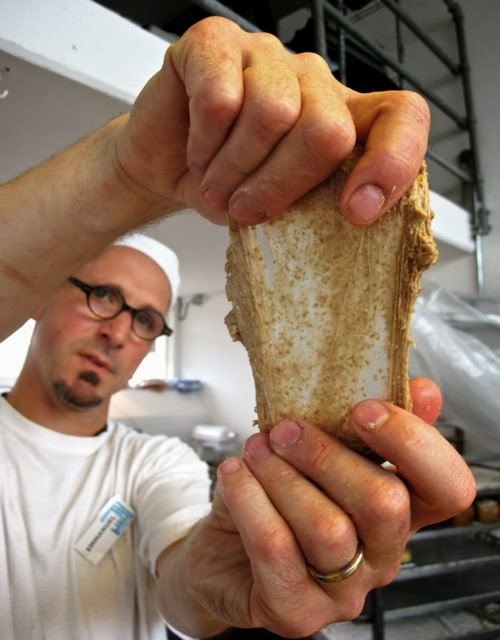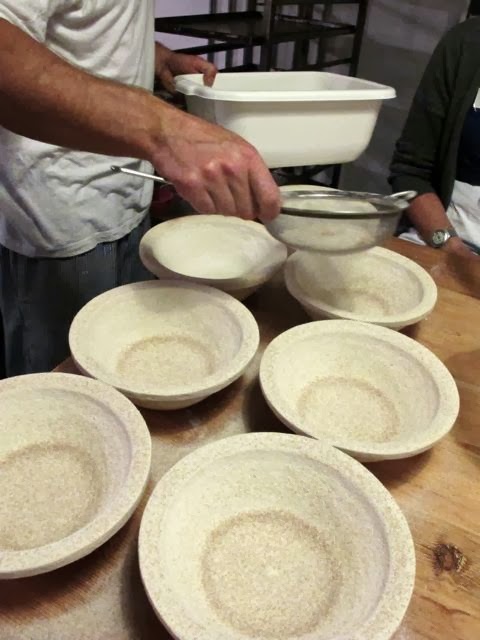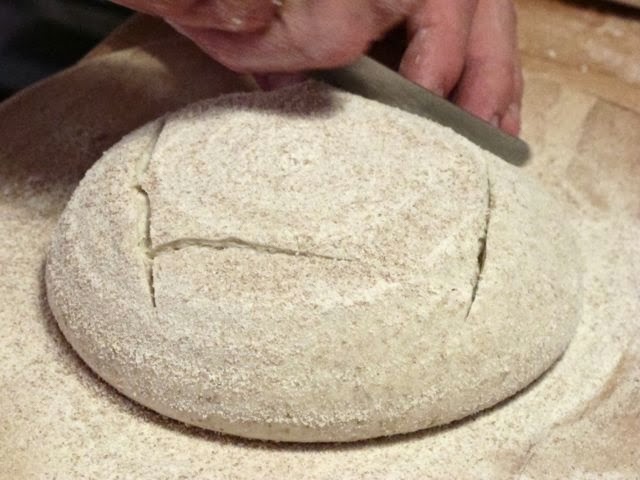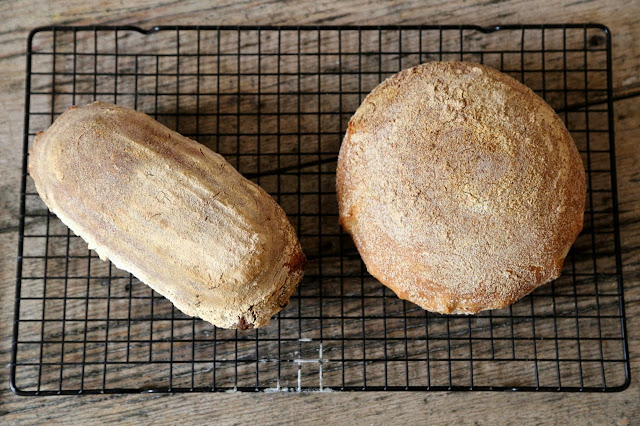 |
| Gluten! We loves it. Emmanuel Hadjiandreou. |
This is following Emmanuel Hadjiandreou’s technique. Which has worked like a dream for me. The great thing about his method is there is none of this throwing half the starter away rubbish. You don’t have to waste flour. I always hated having to throw away starter.
Why is this? Effectively, once you have your live mother, you keep it in the fridge and just use a tiny bit every day to make a poolish or pre-ferment. (Yes poolish is connected to Poland. The person that invented this technique was a Polish baker living in France. Actually the French invented sourdough, someone took that to San Francisco, where they perfected their own sourdough).
As stated in the last post How to cure a sick mother, you have taken 5g of your starter, and added 50g of flour (rye is best to get it going again, white is fine too) and 50g of luke warm water. You’ve covered it and left it over night.
You now have 105g of sourdough starter. But overnight your starter will have lost 10g so call it 95g.

What to do now?
1) Now take 75g of it. Put the rest back in the fridge. If you are not baking again for a while, you can add it back to your original revived mother. (If you are going to bake again very soon, you can keep the 20g and feed it with 50g of flour, 50g of water, leave overnight, do the whole cycle again.)
Babes, I want you all to be gram perfect. I want you to become anal about weighing.

11) Preheat your oven to 250C. Place a shallow tray in the bottom and a flat baking tray in the middle.








I used to work in a bakery. It's a really good idea to slash them because you get a more even and often better rise in the oven. You do have to use a really sharp serrated knife and be confident with it.
It's not lack of confidence, I literally forget every time.
More timely advice! Thanks.
I always had a problem with my dough spreading out and not having much oven spring (the initial burst of rising when the heat hits the dough and it begins to bake). My oven isn't up to scratch basically, so now I always use a cast iron lidded pot (think some people call them Dutch pots), so creating an oven in my oven.
I put the pot with lid in the oven to heat up. Once oven reaches temperature, I tip the dough into the pot, slash the top if I remember to, replace lid and bake at 250C for 35 mins, then remove the lid, lower oven temp to 220C and bake for further 25 mins.. I make a loaf twice the size of the one in your recipe, so that's why the baking times longer, so adjust to suit a smaller loaf. I get really reliable results this way and great oven spring.
I did the Dutch oven technique for a while but with Emmanuel's technique I now have well structured loaves that don't spread out into pancakes. I like this size loaf, it's perfect for someone living alone too!
I'm very fond of my retro English Electric 60's oven (with teal coloured splashback) and I've learnt how to get good results from it. No doubt most people are more up to date than I am and have ovens that are more efficient.
Thank you twice over – for the chef-resurrection advice and also for this recipe, both of which worked a treat. So little effort compared with other sticky-sourdough-up-to-the-elbows experiences I've had. Plus a really great crust.
Yay! I'm so glad it worked for you.
Great, thats look easy steps. Thanks 😉
Thanks for that. Just want to point out that the French did not invent sourdough. Sourdough goes back to ancient Egypt. Before sourdough was discovered they only ate unleavened bread. Then in Ancient Egypt it was discovered that flour and water mixed together and left for a few days began to bubble and rise. Leavened bread was born. Yes, many methodologies have been invented over the years of which Poolish is one but by no means does this mean Sourdough is French.
Hi, can you explain what do you mean by doesn't need to throw away half of the starter? Do you mean in the process of culturing the starter we dont need to discard any at all? At which day of the starter can I start this? Thanks.
Once you have a starter, however long it has taken you to make, or get one from someone else, usually the technique is to keep 'refreshing' it by throwing away most of it and adding flour and water. With this technique, you make a pre-ferment and you need very little starter to get a pre-ferment going. Literally a few grams.
Hi,
Can I ask you at what stage you're at. Do you wish to make a starter or do you have one and wish to bake with it?
In the process of making a starter, and keeping it, many find they have to discard to stop building too much. But with careful management we can keep this to a minimum or not at all. Depends on how often you bake and how you use it.
If you wish on more advice then feel free to ask.
Gee thanks for the patronising comment
Do you mean my comment replying to original question by Anonymous!
I didn't realise you were replying to another Anonymous! Sorry! (why is everyone bloody anonymous anyway?)
Great, thats look easy steps. Thanks 😉
late posting:
The starter has to be fairly active to get the major ferment going, which is why I thought folks kept it refreshed…. and wasted a lot of flour…..
going to give it a go as I am a Dutch pot user, my freestyles blow out one side…. not a good look.
Good stuff K
Haha…yeah mine aren't beautiful shapes either. Got to back on the sourdough thing this autumn. Too darned hot right now.
Do you have a gluten free sourdough recipe?
Thanks
I don't, I'm sorry. I've made gluten free bread once, using Doves gluten free flour. It made me feel extra sorry for all the coeliacs!
I'm never sure about Rye. Is rye OK?
Rye has gluten in it. But you can make sourdough with rye.
If sourdough rye is OK then should be quite easy. The trick with rye is very high hydration and make it like a cake. Prepare your rye starter, mix everything into a batter, go straight into final proofing and bake. You need to go as high as 90% hydration. So off the top of my head…
500g rye flour
442g water
10g salt
150g mature rye starter at 100% hydration
Prepare your rye starter the night before: 30g starter + 60g rye flour + 60g water
Next morning…
In your dough bowl mix the 150g mature rye starter into 442g water.
In another bowl mix the 500g rye flour and 10g salt then add to the starter/water mix.
Stir until completely incorporated and its a thick batter.
Then transfer to suitable loaf tin and smooth over.
Then go straight into final proofing. When small wholes begin to appear on top it is ready to bake in a preheated oven. But don't wait till too many appear.
Or you could sprinkle with rye flour after you have transferred it into a loaf tin and when it rises the flour will crack and look like a map. It'll be ready to bake.
I think I have an all rye sourdough with raisins recipe which I'll have to find. I'll post it asap.
Raisin Rye Bread by Emmanuel Hadjiandreou
INGREDIENTS:
150g dark rye flour
100g rye sourdough starter
200g + 1 tablespoon cold water
200g dark rye flour
6g salt
200g sultanas / golden raisins
150g hot water (not boiling, hot!)
900g loaf pan greased.
METHOD:
1. In a bowl mix the 150g dark rye flour + starter + 200g and 1 tablespoon water. Cover and leave to ferment overnight. This is the wet mixture.
2. Next day… In another bowl mix the 200g dark rye flour + salt + sultanas. This is the dry mixture.
3. Tip the dry mixture into the wet mixture. Do not mix yet!
4. Carefully pour the 150g hot water over the dry mixture.
5. Quickly mix together and form thick batter.
6. Spoon the mixture into prepared loaf pan.
7. Dip plastic scraper or spoon into water and smooth over.
8. Cover and let rise for about 2 hours.
9. About 15 minutes before baking preheat oven to 240C (475F). Place a roasting pan on the bottom of the oven to preheat. Fill a cup with water and set to one side.
10. When the dough has finished rising remove the covering.
11. Place the loaf in preheated oven, pour the cup of water into the roasting pan and lower the temperature to 220C (425F).
12. Bake for about 30 minutes or until brown.
13. Take the loaf out of the pan and set on wire rack to cool.
14. Bon Appetite 🙂
I tried Hadjiandreou's starter method. I did the tablespoon from the mother and added 1 cup of flour and 2/3 water. Bubbled beautifully but then as a dough (in both proofs using Ed Wood's recipe) it did not rise. Only rose a bit in the final baking, and that not much.
hmm. I know what you mean. After a while I had the same problem. I'm not sure why.
If the starter bubbles then the bread will rise. However there are so many variables one must take into account…
1. Are you allowing the starter to mature enough?
2. Going by the dough and not the clock have you allowed enough time for the bulk ferment?
3. Again, judging by the dough and not the clock, have you allowed enough time for final proofing?
Judging by the minimal info given it sounds as if you've under done the starter build or bulk ferment. Everyone's starter is unique and you need to learn what the starter and dough, looks and feels like, during each stage.
As a very brief guide you should do the following…
1. Starter should peak and just begin to fall.
2. Or you can drop a bit of starter into some water and see if it flats.
3. The dough should have full gluten formation and be aireated before going onto final proofing.
4. Gluten formation is done when you gently press the dough and it springs back immediately.
5. It'll have fine veins in the dough.
6. It'll be billowy but not necessarily doubled.
Try and try again. Best of luck.
I have made bread from this recipe and it has been good !! But there is one thing I am not certain about….I keep the 'mother' in the fridge and have had it for 2 moinths now without problem and when I want to make bread, I take 15g and mix it with 150g flour and 150g warm water to create the 'poolish'. However, as I only makee one loaf at a time, I have loads of 'poolish' left. Do I just throw this away ?
I have made bread with this recipe and it is very good but I have one little area where I am not clear:
I use 15g of 'mother' mixed with 150g flour and 150g warm water to create the 'poolish' but as I only make one loaf at a time, I have too much 'poolish'. What do I do with this, throw it away?